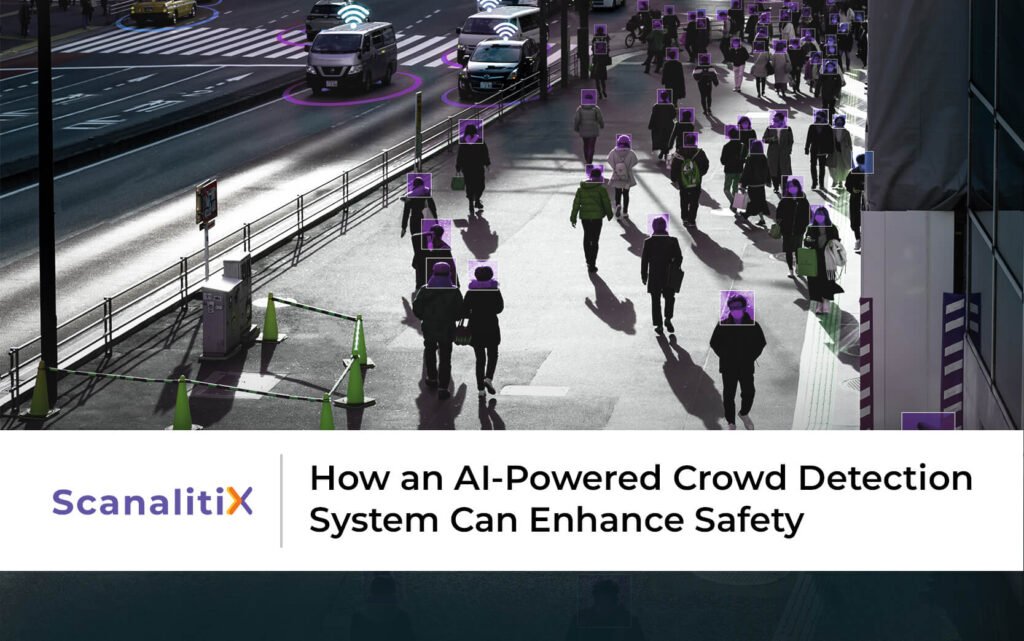How an AI-Powered Crowd Detection System Can Enhance Safety

Table of Contents
Safety in public spaces depends on information, awareness, and rapid response. People gather. Risks follow. Festivals, transport hubs, stadiums, and shopping centers draw large crowds. These gatherings form quickly, and so do the safety risks. A crowd detection system powered by artificial intelligence changes how organizations manage this risk. It turns ordinary cameras into intelligent observers that see more, process faster, and react quicker.
What Is a Crowd Detection System?
A crowd detection system identifies patterns in human gatherings using visual data. It recognizes crowd formations, density levels, abnormal movement, and sudden influxes. With AI, this capability scales up. Machine learning models process camera feeds in real time, spotting dangerous buildups before they become emergencies.
The system is not just about detecting people. It is about recognizing behavior. Are crowds forming too quickly? Are exits getting blocked? Is there a sudden panic wave? An intelligent system answers these questions in milliseconds.
Why Crowds Pose a Safety Risk
Crowds can escalate from normal to chaotic in seconds. Overcrowding leads to suffocation, stampedes, and even death. According to a report by the World Health Organization, crowd crashes have caused hundreds of fatalities in a single event when safety protocols were missing or reactive.
Large groups also attract threats. Suspicious behavior, unattended objects, or acts of aggression are harder to notice when visibility drops. Human monitors may miss details. A crowd detection system never blinks.
Real-Time Awareness in High-Risk Zones
High-density areas demand more than basic surveillance. Transport terminals and religious gatherings need a crowd detection system to ensure safety. E-surveillance teams no longer rely on guesswork. AI algorithms analyze body movement, speed, and clustering to predict potential trouble spots.
These systems trigger alerts based on preset thresholds. If foot traffic in a corridor spikes by 150% within 10 minutes, the system instantly flags the surge. Security staff respond, reroute the flow, or send support. This type of real-time data saves lives.
Predictive Insights, Not Just Alerts
The advantage of AI lies in foresight. A crowd detection system learns from past patterns. It doesn’t wait for crowds to cross danger thresholds. It identifies buildup trends and gives early warnings.
Say a mall typically sees a lunch-hour spike in its food court. On a holiday, that spike may double. The system detects the anomaly and alerts operations teams before it escalates. More staff are deployed. Entry routes get adjusted. Risks are reduced before they arise.
Enhancing Emergency Response
Emergencies create confusion. People run in all directions. Traditional e-surveillance fails to track everyone. A crowd detection system maps live movement and locates trouble zones instantly.
Fire in a subway? The system pinpoints the largest crowd buildup, identifies congested exits, and directs responders to the best entry points. Law enforcement sees live heat maps. Decision-makers take faster, informed action. Every second counts. A crowd-aware AI shortens response time, giving security teams the critical edge they need to act fast and prevent incidents before they escalate.
Supporting Law Enforcement and Event Managers
Large events are vulnerable. Football games, concerts, and parades attract thousands. Crowd control becomes a science. A crowd detection system gives organizers a layer of control that no manual team can match.
The system detects sudden shifts in crowd behavior. Maybe a fight breaks out. Maybe someone collapses. Perhaps an exit bottleneck. AI sends instant signals. Officers respond before the issue spreads.
With facial recognition or license plate integration, it can even track specific individuals inside a crowd. That improves situational awareness without invading privacy.
Crowd Management in Urban Planning
City planners use crowd detection systems to analyze public behavior. Which parks fill up fastest? Which crosswalks get congested? Which train platforms need redesign? The system gathers detailed movement data over several months. It provides heatmaps, peak time analysis, and flow simulations. That allows smarter infrastructure decisions.
For example, Tokyo’s rail system uses AI-powered crowd analytics to reduce congestion across its busiest lines. It has improved the passenger experience and cut down crowd-related incidents.
Retail and Commercial Space Benefits
It is not just about safety. Malls, casinos, and airports rely on crowd detection systems to analyze foot traffic and improve space utilization.
Where do customers spend the most time? Which areas stay empty? What’s the average wait time during peak hours? These answers help enhance the experience while maintaining safety.
Heatmaps also guide marketing. Digital ads get placed in high-traffic zones. Staffing schedules align with actual crowd patterns and flow. Customer satisfaction improves without extra manpower.
AI Adds Scalability to E-Surveillance
Manual crowd monitoring has limits. Human operators can only manage a limited number of screens. Attention spans fall. Mistakes happen. A crowd detection system works nonstop.
AI scales across hundreds of cameras. Whether monitoring 5 or 500 locations, the system maintains precision. The system does not sleep. The system does not miss queues. The system processes gigabytes of video without bias. Scalability makes it ideal for both small venues and city-wide implementations.
Privacy and Compliance Built In
A common concern with video analytics is privacy. A well-designed crowd detection system avoids identity tracking unless explicitly required. It focuses on behavior, not faces.
Modern systems anonymize data and follow regional compliance laws. GDPR, HIPAA, or any location-specific regulation can be enforced. Transparency and accountability stay intact. Organizations can use AI for safety without compromising public trust.
Turning Footage into Foresight
Safety demands intelligence. A crowd detection system delivers it. From monitoring public gatherings to managing emergencies, it redefines e-surveillance with speed, scale, and insight.
Scanalitix powers this transformation through AI video analytics. The platform helps organizations unlock advanced detection capabilities using their existing infrastructure. It reads patterns, analyzes risk, and facilitates operations teams to stay steps ahead.
